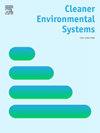Life cycle assessment (and environmental footprint) to support food labelling schemes: an overview of current proposals and future directions
IF 4.9
Q2 ENGINEERING, ENVIRONMENTAL
引用次数: 0
Abstract
Sustainability labelling gained prominence in food policy discourse in recent years, particularly in Europe, although its effectiveness in influencing consumer behaviour remains uncertain. This work explores selected sustainability food labels in the EU, reviewing sustainability indicators and the underlying life cycle assessment (LCA) methodologies. It addresses methodological approaches, and how they apply LCA with reference to the Product Environmental Footprint (PEF) method recommended by the European Commission. Four labels were identified from a comprehensive product database, focusing on labels applying LCA and quantifying multiple impacts, while an additional one was identified from the current EU panorama. An evaluation framework was developed on the relevant methodological aspects, encompassing governance, transparency, and clarity. Interviews with label developers complemented the analysis, along with a review of criticisms of LCA and PEF for labelling purposes. Four are scoring labels providing graded and colour-coded visuals, while one is still under development. Methodological adaptations to the PEF were common, and non-LCA sustainability assessments accounted for aspects such as farming management, social issues, and biodiversity. Labels varied in transparency, stakeholder involvement, and clarity. Criticisms of LCA include its reductionist approach, data gaps, and lack of robust methodologies for assessing biodiversity. While sustainability labelling is important to guide sustainable choices, labels need to be part of a broader policy mix and should be underpinned by clear goals and robust methodologies. This analysis will help to develop evidence-based policy instruments for sustainable consumption and set the basis for a harmonized labelling system.
支持食品标签计划的生命周期评估(和环境足迹):当前建议和未来方向概述
近年来,可持续性标签在食品政策话语中获得了突出地位,特别是在欧洲,尽管其在影响消费者行为方面的有效性仍不确定。这项工作探讨了欧盟选定的可持续性食品标签,审查可持续性指标和潜在的生命周期评估(LCA)方法。它讨论了方法方法,以及它们如何根据欧洲委员会推荐的产品环境足迹(PEF)方法应用LCA。从综合产品数据库中确定了四个标签,重点关注应用LCA和量化多重影响的标签,同时从当前的欧盟全景中确定了另外一个标签。在相关的方法方面开发了一个评估框架,包括治理、透明度和清晰度。与标签开发商的访谈补充了分析,以及对LCA和PEF用于标签目的的批评的回顾。四个是评分标签,提供分级和颜色编码的视觉效果,而一个仍在开发中。对PEF的方法调整是常见的,非lca可持续性评估考虑了农业管理、社会问题和生物多样性等方面。标签在透明度、涉众参与度和清晰度方面各不相同。对LCA的批评包括其简化方法、数据缺口以及缺乏评估生物多样性的可靠方法。虽然可持续性标签对指导可持续选择很重要,但标签需要成为更广泛的政策组合的一部分,并应以明确的目标和有力的方法为基础。这项分析将有助于制定以证据为基础的可持续消费政策工具,并为统一的标签制度奠定基础。
本文章由计算机程序翻译,如有差异,请以英文原文为准。
求助全文
约1分钟内获得全文
求助全文
来源期刊

Cleaner Environmental Systems
Environmental Science-Environmental Science (miscellaneous)
CiteScore
7.80
自引率
0.00%
发文量
32
审稿时长
52 days
 求助内容:
求助内容: 应助结果提醒方式:
应助结果提醒方式:


